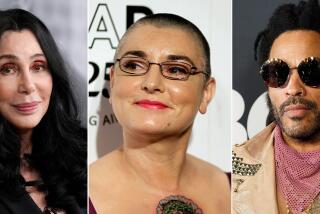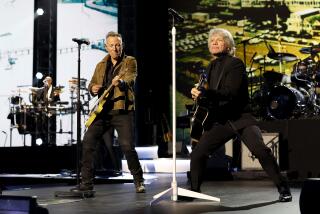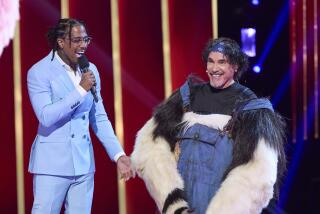For Hall and Oates, a new appreciation
Daryl Hall and John Oates, the Hugo Boss-clad kingpins of Reagan-era pop, seemed destined for the casino-circuit dotage most pop stars eventually face -- their new music largely ignored, their fan base fading to nothingness. But then, around 2005, something strange happened. A real H&O revival began.
FOR THE RECORD:
Hall & Oates: An article in Monday’s Calendar section about the pop duo Hall & Oates described the hip-hop group Gym Class Heroes as being from Chicago. The band is from Geneva, N.Y. —
This reassessment of the most commercially successful duo in pop history hits a peak Tuesday, when H&O receives the Icon award during BMI’s 56th annual Pop Awards, joining the likes of Paul Simon, Van Morrison and the Bee Gees. They’ll follow this honor Thursday and Friday with two rare nights at the Troubadour, the site of their first Los Angeles shows some 35 years ago.
Like many megastars who’ve survived past their commercial peak, H&O have been embraced by a new generation, though it hasn’t always been clear if the new fans’ motives are totally sincere. What began in the early 2000s as fond satire -- a hairy Oates and swanlike Hall were parodied on “Yacht Rock,” the popular Internet series poking fun at the turn-of-the-’80s soft-rock scene -- progressed into the widespread acceptance of H&O’s music as a guilty pleasure, still critically questionable, perhaps, but hard to resist.
At that point, along with artists like Journey and Phil Collins, Hall and Oates became part of an emerging category: Call them the indefensible greats.
If Daryl Hall and John Oates had merely resurfaced as characters in comedic confrontations with the recent past, their return would mean little musically. But the surge in interest has gone further than a wallow in questionable nostalgia. A couple of years ago, younger artists began to temper the jokey tone of those “Yacht Rock” references with sincere declarations of love for the group. Ben Gibbard of Death Cab for Cutie published a playlist of his favorite H&O songs in the Internet indie bible Pitchfork.com. Brandon Flowers of the Killers declared “Rich Girl” the most instructive pop single ever written.
Praise flowed from hip-hop artists too -- Chicago crew Gym Class Heroes even went so far as to record a “matchup” album, combining their songs with H&O classics, though a legal notice from Atlantic Records (not from H&O, who fully endorse the project) has put it on hold for now. This overflow of love for H&O has been taken up by music writers, who’ve dug into the group’s deep catalog and discovered that its merits extend beyond the forced frivolity of camp.
The H&O revival is deserved on artistic terms, but there’s a deeper story here. In particular, two qualities that characterize the hits of this long-lived band resonate with younger listeners: their truly equal footing in both rock and R&B and their belief that accessible and artistically adventurous music could be one and the same.
During the height of their success, pop music tastemakers regularly expressed contempt for overt commercialism. A few hugely influential artists, like Michael Jackson and (eventually) Madonna, demanded universal respect. But in general, the cultivation of accessible pleasure in pop was a mark of shame. Integrity came from rawness, independence from trends and an undying allegiance to the personal muse. To be smooth, chic and eager to reach as many ears as possible made you a sellout, or an airhead.
Embracing innovation
Also, the war between album-oriented rockers and disco fans fed the rift between “white” and “black” music that had been building throughout the 1970s. Many rock enthusiasts clung to an idea of what “real” black music should be -- basically blues, reggae and gritty soul.
Given these restrictions, how could Hall and Oates have been considered cool in their prime? They’d cut their chops working with soul greats Kenny Gamble and Leon Huff, but they were white, and like their mentors, favored rich arrangements that gave their songs an upper-middle class sheen.
Complicating matters, not only was Hall, the duo’s main soul man, not black -- he looked (still looks!) as refined and ruthlessly handsome as an Ivy League scion in his “Less Than Zero” phase. Never mind that his pals included August Darnell, the postmodern Creole whose music set the stage for Prince, and Arthur Baker, who produced Afrika Bambaataa’s “Planet Rock.” To most people, this working-class veteran of the Philly soul scene looked like a rich boy who’d gone too far.
Like early 1980s R&B, the best-known songs of Hall and Oates embraced innovation while aiming for mainstream acceptance. They were among the first major artists to use drum machines and synthesizers, and their 1984 album “Big Bam Boom,” a collaboration with Baker, pioneered rock’s fusion with hip-hop.
Dedicated hit makers
Yet even though Hall explored art rock in side projects with King Crimson guitarist Robert Fripp, the pair remained dedicated hit makers. This was another legacy of Gamble and Huff, whose production was always experimental and seductive. Oates, whom Hall acknowledges as the “finisher” on many of the pair’s biggest songs, is a master of catchy choruses. Hall’s early years as a soul session man helped him develop one of the pop’s most gorgeous singing styles.
All of these qualities -- the smart commercialism, the race-crossing sound, the prettiness -- turned off the punks and indie rockers who played guard over “good” music well into the 1990s. But the H&O paradigm suits the emerging values of the generation now dominating smart pop.
Growing up in the aftermath of Kurt Cobain’s fatal inner conflict over “selling out,” and inheriting a cultural playing field impossibly broadened by the Internet, musical tastemakers in their 20s and early 30s don’t care much for the idea of purism. They’re also essentially entrepreneurial; most desire commercial success.
And, crucially, these young H&O fans speak the language of hip-hop. The duo’s songbook has always been a treasure trove for samplers: De La Soul, Heavy D, the Wu Tang Clan and Wyclef Jean have all dug in. Hall and Oates have embraced these borrowings, collaborating with their youthful admirers whenever possible -- Hall through his regular webcast, “Live From Daryl’s House,” and Oates by forging links with bluegrass innovators like Jerry Douglas.
Those 21st century dreamers might not realize that the suave guys behind “Private Eyes” went through their own struggles; they played around with art rock and folk-pop for years before hitting on their signature sound, and their more daring experiments never found the audience they deserved.
Hall and Oates have bequeathed the world a quarter-century’s worth of songs, familiar and more obscure, made together and separately. Exploring their discography is a joy. But whatever dream these two friends embody right now, they’re still focused on the day-to-day reality of making music. And beyond whatever values that music represents, it’s still a spine-tingling experience to hear Daryl Hall sing “Sara Smile.”
More to Read
The biggest entertainment stories
Get our big stories about Hollywood, film, television, music, arts, culture and more right in your inbox as soon as they publish.
You may occasionally receive promotional content from the Los Angeles Times.






